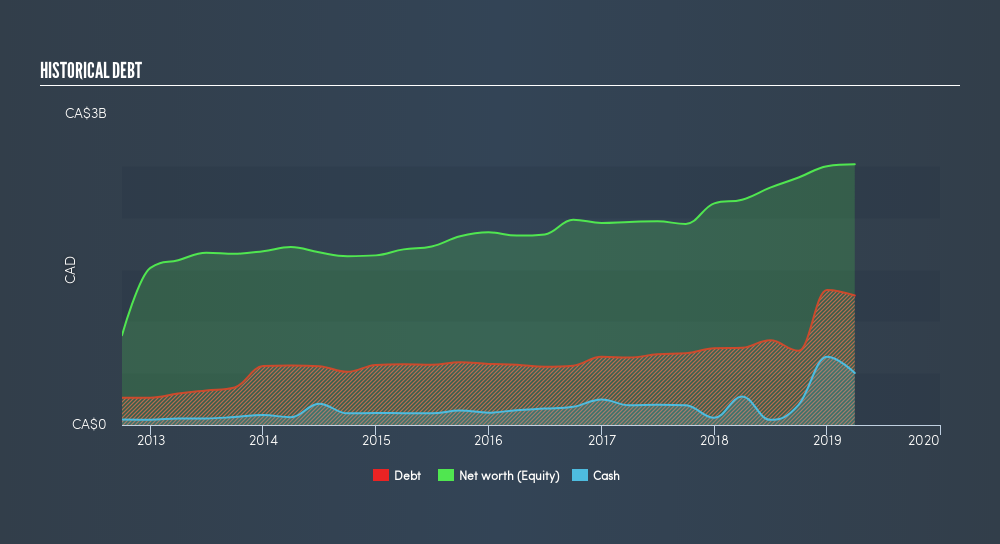
Want to participate in a short research study? Help shape the future of investing tools and you could win a $250 gift card!
Granite Real Estate Investment Trust is a CA$3.0b mid-cap, real estate investment trust (REIT) based in Toronto, Canada. REITs are basically a portfolio of income-producing real estate investments, which are owned and operated by management of that trust company. They have to meet certain requirements in order to become a REIT, meaning they should be analyzed a different way. I’ll take you through some of the key metrics you should use in order to properly assess GRT.UN.
See our latest analysis for Granite Real Estate Investment Trust
Funds from Operations (FFO) is a higher quality measure of GRT.UN's earnings compared to net income. This term is very common in the REIT investing world as it provides a cleaner look at its cash flow from daily operations by excluding impact of one-off activities or non-cash items such as depreciation. For GRT.UN, its FFO of CA$158m makes up 76% of its gross profit, which means the majority of its earnings are high-quality and recurring.

In order to understand whether GRT.UN has a healthy balance sheet, we have to look at a metric called FFO-to-total debt. This tells us how long it will take GRT.UN to pay off its debt using its income from its main business activities, and gives us an insight into GRT.UN’s ability to service its borrowings. With a ratio of 12%, the credit rating agency Standard & Poor would consider this as significantly high risk. This would take GRT.UN 8 years to pay off using just operating income, which is a long time, and risk increases with time. But realistically, companies have many levers to pull in order to pay back their debt, beyond operating income alone.
Next, interest coverage ratio shows how many times GRT.UN’s earnings can cover its annual interest payments. Usually the ratio is calculated using EBIT, but for REITs, it’s better to use FFO divided by net interest. This is similar to the above concept, but looks at the nearer-term obligations. With an interest coverage ratio of 7.04x, it’s safe to say GRT.UN is generating an appropriate amount of cash from its borrowings.
In terms of valuing GRT.UN, FFO can also be used as a form of relative valuation. Instead of the P/E ratio, P/FFO is used instead, which is very common for REIT stocks. In GRT.UN’s case its P/FFO is 19.12x, compared to the long-term industry average of 16.5x, meaning that it is slightly overvalued.
Next Steps:
In this article, I've taken a look at Funds from Operations using various metrics, but it is certainly not sufficient to derive an investment decision based on this value alone. Granite Real Estate Investment Trust can bring about diversification for your portfolio, but before you decide to invest, take a look at the other aspects you must consider before investing:
- Future Outlook: What are well-informed industry analysts predicting for GRT.UN’s future growth? Take a look at our free research report of analyst consensus for GRT.UN’s outlook.
- Valuation: What is GRT.UN worth today? Is the stock undervalued, even when its growth outlook is factored into its intrinsic value? The intrinsic value infographic in our free research report helps visualize whether GRT.UN is currently mispriced by the market.
- Other High-Performing Stocks: Are there other stocks that provide better prospects with proven track records? Explore our free list of these great stocks here.
We aim to bring you long-term focused research analysis driven by fundamental data. Note that our analysis may not factor in the latest price-sensitive company announcements or qualitative material.
If you spot an error that warrants correction, please contact the editor at editorial-team@simplywallst.com. This article by Simply Wall St is general in nature. It does not constitute a recommendation to buy or sell any stock, and does not take account of your objectives, or your financial situation. Simply Wall St has no position in the stocks mentioned. Thank you for reading.
Market Insights
Community Narratives



